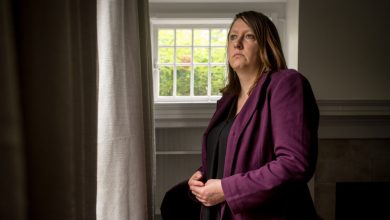After Supreme Court Ruling, DEI Work Gets More Challenging and Crucial, Experts Say

[ad_1]
In the aftermath of the Supreme Court’s decision last week outlawing race-conscious admissions, college administrators who work in diversity, equity, and inclusion say that their efforts to recruit and retain a diverse student body, and to help students of color feel a sense of belonging, are even more critical now that colleges will not be allowed to consider race as a factor in admissions.
While some administrators said they may have to tweak some of their tactics, several interviewed by The Chronicle said their work could become even more challenging if the number of students of color on campus shrinks, as experts expect.
The Supreme Court ruling also comes at a time when conservative politicians in many states have attacked colleges’ work in diversity, equity, and inclusion; The Chronicle is tracking 38 bills that were introduced in 21 state legislatures this year to restrict DEI efforts in higher education. So far, six of the bills have been signed into law, with some restricting specific diversity strategies, such as the use of diversity statements, while others, including one in Texas, ban diversity offices and staff at public institutions altogether.
According to a Chronicle analysis, at selective institutions that admit less than 25 percent of applicants, underrepresented-minority students make up 29.6 percent of enrollments; at less-selective institutions, such students compose 40.9 percent of the enrollment.
Since last fall, James A. Felton III, vice president for inclusive excellence at the College of New Jersey, has been meeting with an informal working group, including the public college’s vice president for enrollment management, director of admissions, legal counsel, and provost, to discuss how a Supreme Court ruling against race-conscious admissions might affect the campus.
The group has discussed the potential impact of such a ruling on its high-demand programs and whether the college — which is a selective institution that did consider race in admissions — might be able to expand its reach into geographic markets it hasn’t traditionally targeted, for example.
Now that the Supreme Court has ruled against race-conscious admissions, the group will take some time to digest the decision and weigh it against the college’s current programs, initiatives, and policies before creating an action plan in time for the fall’s recruitment season, Felton said.
For example, some of the college’s scholarship and grant programs assess students holistically, and may consider a student’s race and background. But the college does not expect changes in the programs.
“I don’t think it, for me, will have a major bearing on the vision and the mission and goals of our institution, as well as higher education over all,” Felton said, noting that New Jersey has not enacted any anti-DEI legislation. “I think the Supreme Court decision just compels institutions to consider new and strategic ways to approach the work.”
But Felton expects the ruling will shrink the number of Black and Latino students on campus, which means the scope and scale of programs the college can offer, all of which are open to people of all backgrounds, will also probably decline.
The California Precedent
John B. King Jr., chancellor of the State University of New York system, said the role of chief diversity officer had become even more important in light of the Supreme Court ruling. Chief diversity officers will need to work with campus leaders to forge a path forward that is consistent with the law but also honors a commitment to diversity, equity, and inclusion, King said.
“If you look at what happened in California and in Michigan,” King said, “one of the challenges when the tool of race-conscious admissions was removed is that you had a precipitous drop in the presence of students of color, and that makes it that much harder to create a climate of belonging.”
California’s voters banned race-conscious admissions at public universities in 1996 through a ballot measure, Proposition 209, so Kathleen Wong(Lau), university diversity officer at California State University-East Bay, has been working without race-conscious admissions for years. Despite spending more than a half-billion dollars on race-neutral alternatives to diversify campuses, the University of California system has struggled to recover Black and Hispanic enrollment, particularly at its most selective institutions. “I’ll be frank,” Wong(Lau) said. “Holistic evaluations have been able to repair some of the loss. It has not been able to completely bring us back up to the point where we were allowed to use race as one of the criteria.”
Wong(Lau) said that senior diversity officers in California had focused on retention and climate, which she believes are not affected by the Supreme Court ruling, but that those efforts can go only so far when the sheer number of students of color in American higher ed remains minuscule. Black students at some public colleges in California can go an entire week without seeing another Black student, Wong(Lau) said, a situation that can make it difficult to create a climate where students really feel as if they belong.
Michael Benitez is vice president for diversity and inclusion at Metropolitan State University of Denver, which, as an open-access institution, is not directly affected by the end of race-conscious admissions. But he worries that prospective students could interpret the Supreme Court ruling to mean that they are not welcome on certain campuses.
“It’s not entirely on the school, but it certainly creates a feeling of perhaps not belonging, or I’m not wanted there, or I’m not going to make it there, or there’s little chance I’m going to get in, and I think so much of it is based on a misperception more than anything else,” Benitez said. As a result, he said, colleges will need to work harder now to communicate to students and families that diversity is still important on their campuses, and that students will have the support and resources they need to succeed.
Caroline Laguerre-Brown, a member of the Board of Directors of the National Association of Diversity Officers in Higher Education, expects to see colleges focus more on recruiting.
“I think that universities are going to start spending a lot more time engaging in pipeline activity … designed to generate that diverse candidate pool,” said Laguerre-Brown, who also serves as vice provost for diversity, equity, and community engagement at George Washington University. “I think a lot of us will be strategizing about ways to reach communities that we haven’t reached in the past to try to encourage … that more-diverse, more-rich candidate pool.”
[ad_2]
Source link






